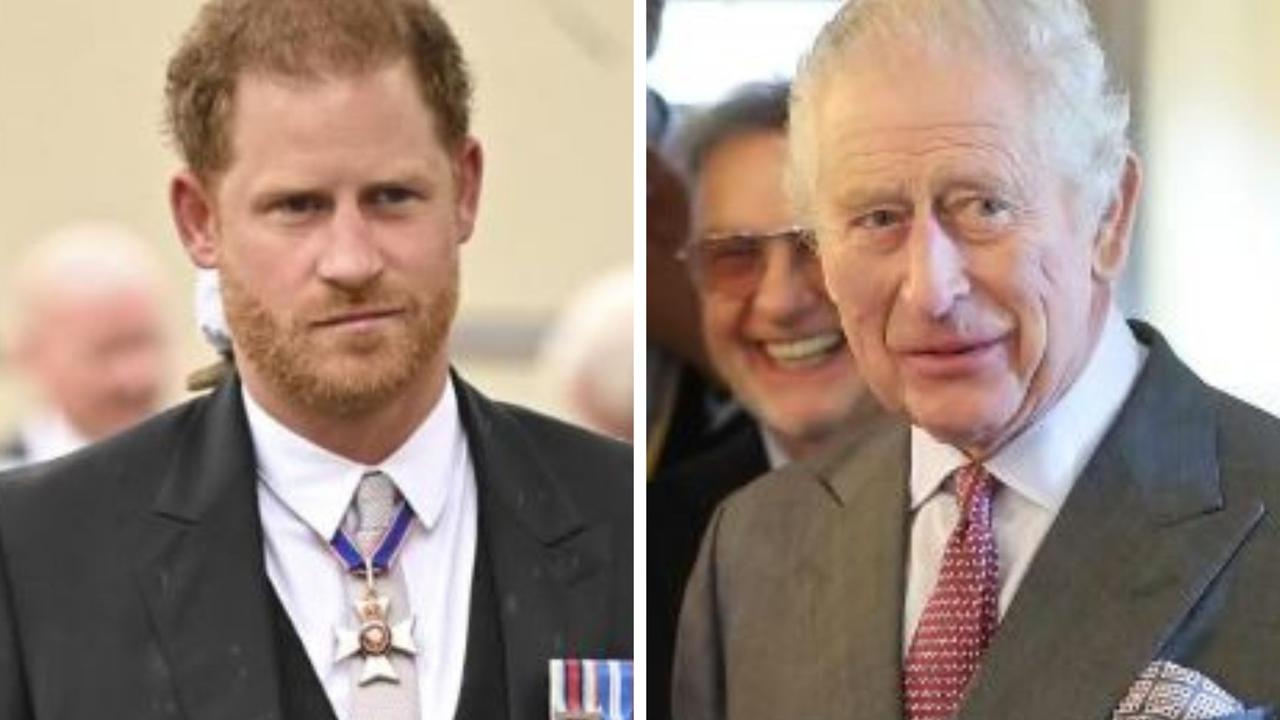Royal guard collapses; Harry and Meghan ‘break ranks’
Dramatic footage has captured a royal guard collapsing near the Queen’s coffin during a service where the Sussexes stood out with one joint move. Watch video.

Royals
Don't miss out on the headlines from Royals. Followed categories will be added to My News.
There was drama during a service for Queen Elizabeth at Westminster Hall in London when a royal guard collapsed near the late monarch’s coffin.
Video shows the man uneasy on his feet before fainting faced down from the podium to the floor as mourners gasped.
The man was helped by police officers and other bystanders but no update on his condition has been made.
He may have suffered “syncope” - a temporary loss of consciousness usually related to insufficient blood flow to the brain caused by locking knees.
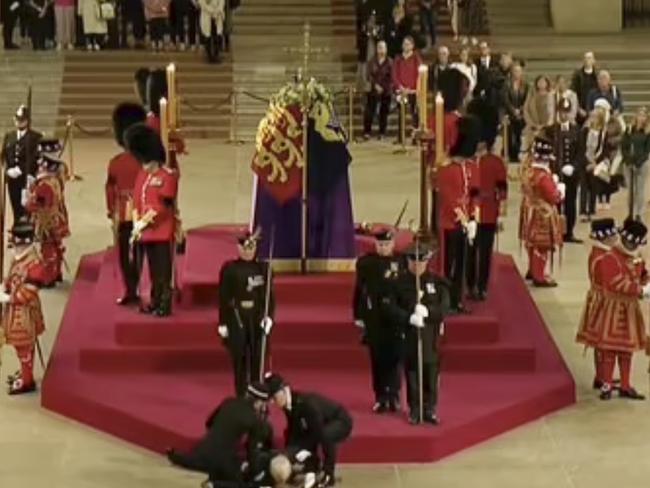
It comes after Prince Harry and his wife Meghan Markle held hands as they followed Prince William and Princess Kate Middleton after the service as the Queen began a period of lying in state.
Heads bowed, the royal family appeared emotional as the historic procession drew to a close.
According to body language expert Judi James, the gesture was “emotionally impulsive” and showed they were both grateful to be back together after earlier being separated by events.
“Meghan and Harry do seem to break rank to hold hands at the end of the service,” Ms James told The Sun.
“It looks like an emotionally impulsive gesture, driven by a need to touch and unite again.
“But it’s hard to not factor in how Harry was not allowed to appear in uniform like the others – apart from Andrew – so possibly felt less restriction in terms of sustaining royal protocol.”


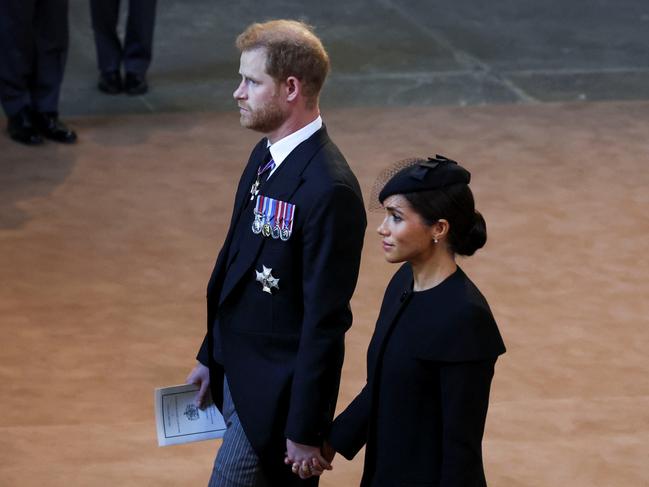



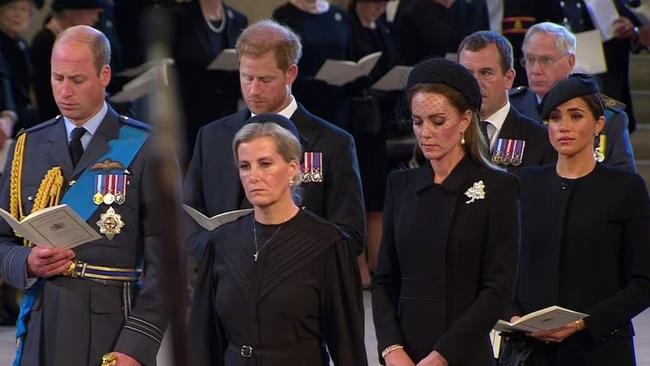

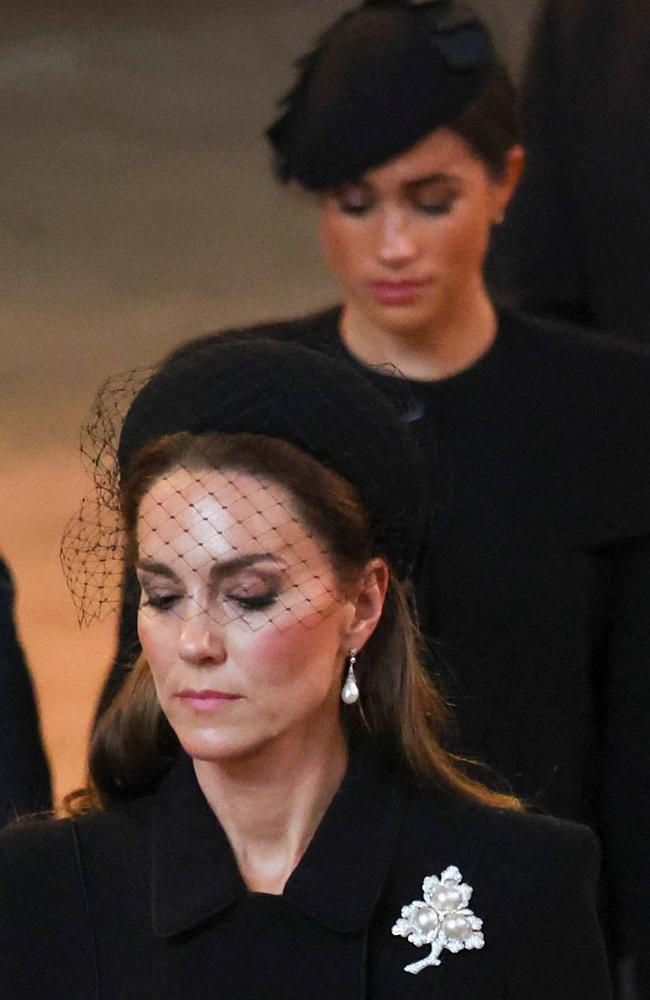

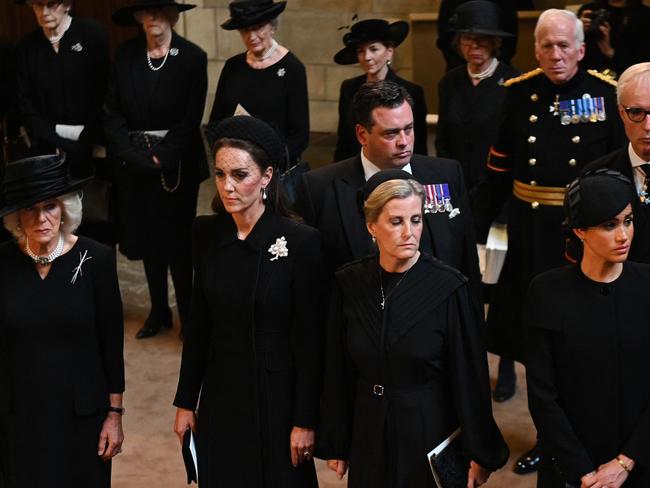



KING CHARLES TAKES A DAY OFF
The King will take a private day of reflection after losing his mother and becoming a monarch.
The 73-year-old has reportedly returned to his Highgrove home in Gloucestershire and is not expected to attend any public events on Thursday UK time.
The day is said to have been included in detailed planning dubbed “London Bridge” for the aftermath of the Queen’s death.
Although he will pause briefly it’s believed he will be working in preparation for his new role.

SOLEMN SCENES AS ROYALS UNITE
Britain’s Queen Elizabeth II departed Buckingham Palace for the very last time after an extraordinary 70 years on the throne and one last night with her family.
A solemn King Charles, Princess Anne, Prince Andrew, Prince Edward, Prince William and Prince Harry followed the Queen’s coffin on foot as the gun carriage procession took her to her next resting place at Westminster Hall, just under two kilometres away.
Prince Edward was inscrutable under his hat. Princess Anne was stoic, seemingly lost to reverie. Prince Andrew seemed determined to maintain that particularly British type, emanating from the jawline, of resilience.
Then there was Charles, the new King. In recent days, he has grown as a source of eloquence and lightness. Britain has turned to him as the new voice for reassurance after his mother fulfilled the duty for seven decades.
But in these private moments, on the most public of stages, he seemed stooped. Glum.
The Queen’s passing may have captivated a wider world which tends to reduce her to titles and powers. Yet her replacement on Wednesday reminded us that her loss was much more personal.


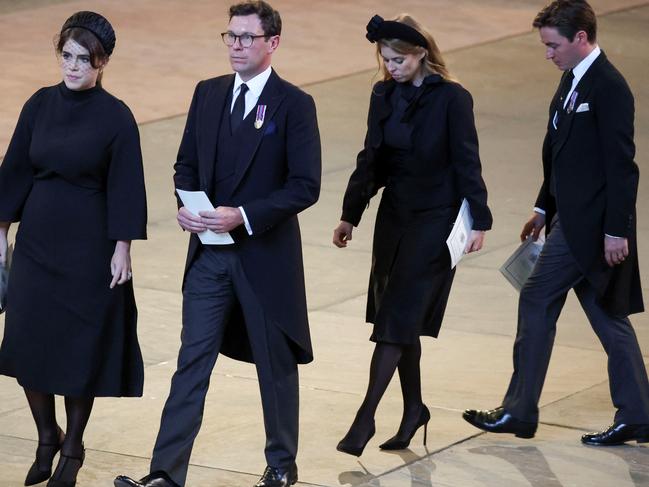

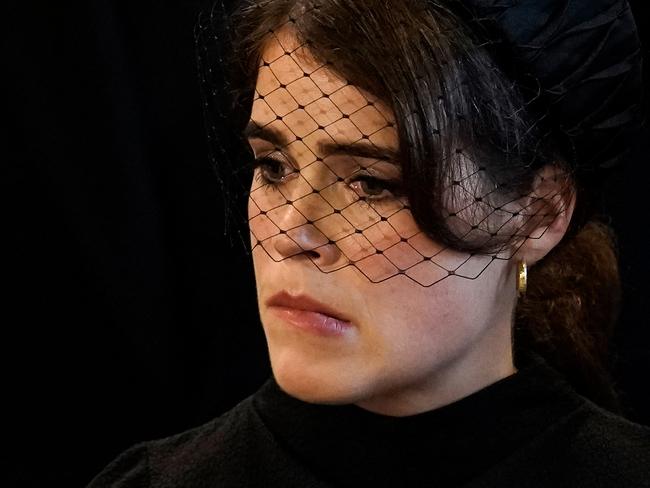
That’s why so many turned out to watch; they thought of the Queen as part of their own families. Some clapped from time to time. But most spectators seemed to adhere to the unspoken expectation of reverence and respect.
After all, that’s what the ancient rituals of a royal procession demand. The features of Wednesday – a horse drawn carriage, the march of mourners in step with the drum – emulated processions from centuries ago. They also stamped what the Queen herself wanted.
Some years ago, she helped choreograph all the important moments after her death. Nothing went wrong at her procession mainly because it was designed to ensure that very little could. Even the horses, for example, were trained to remain calm if flags or flowers were tossed in their path.
This was an exercise in symmetry and simplicity. The upholding of tradition was the prize. Take the coffin, laid only with a wreath, crown and a standard. Even nature followed the script, producing a bright sun and not a breath of wind.
It didn’t go perfectly – what was timed to be a 38-minute walk from Buckingham to Westminster actually ran (deep sigh) to more than 40 minutes.
And there had to be concessions to a modern world and modern threats. As they set down chairs before 8am for prime positions, spectators confronted unprecedented security measures. Steel fencing, perhaps 15 feet high, had materialised overnight in nearby streets, like mini Berlin Walls.



Nothing was too much trouble – not for the Queen. The procession stopped the clocks – and the planes. Heathrow Airport changed plane schedules between 1.50pm and 3.40pm to “ensure silence over central London as the ceremonial procession moves from Buckingham Palace to Westminster Hall”.
Melburnian Pierre – Louis Plumejeau-Wilby camped in the night on parliament Street ahead of the procession.
“It’s only right that we pay our respects to the Queen who has served the country, and Australia, for more than 70 years,” he said.
Dressed in black, he and friends packed bacon rolls, crisps, water and sandwiches to sustain them through 24 hours, even though police had urged mourners not to camp ahead of the procession.
“Australians appear to be impartial about monarchy but they like the celebrity element and the pomp and ceremony that goes with the monarchy,” he said.
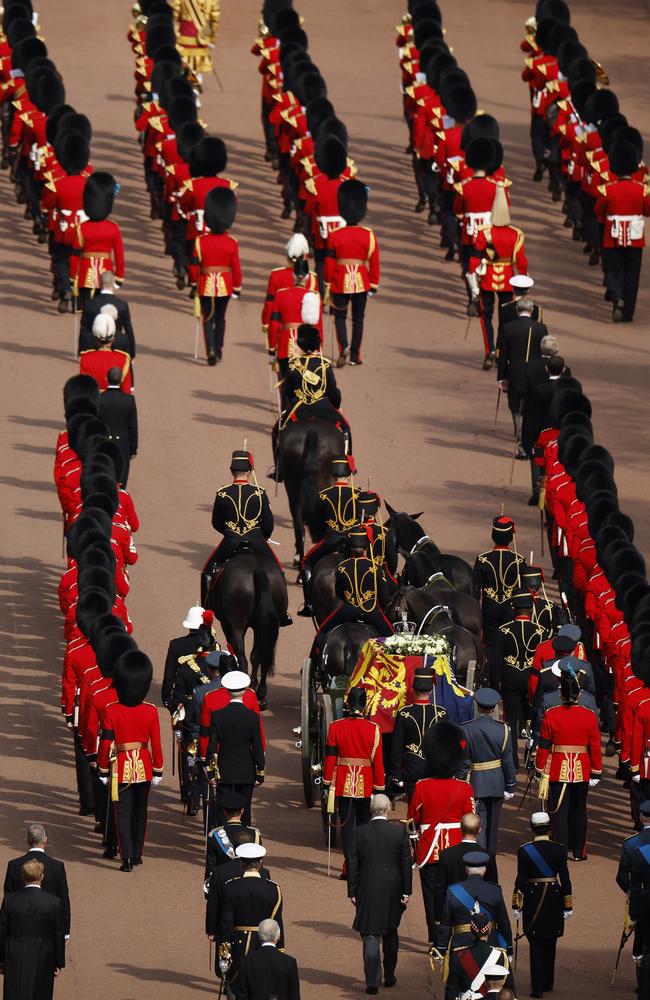

SADNESS REMINISCENT OF DIANA
The procession’s pageantry, amid spontaneous shows of sadness, invoked memories of the emotional outpouring when as boys they followed the coffin of their mother, Princess Diana, in 1997.
Prince William bowed his head and hid his pain under his hair; Prince Harry, a bundle of stiffness, willed himself not to cry. It was different for them this time. They looked composed.
A gun carriage of the King’s Troop Royal Horse Artillery carried the coffin from Buckingham Palace, past an Australian flag at half-mast, for the short journey to Westminster Hall.
Big Ben rang every minute, and minute guns echoed from Hyde Park, as the cortege arrived at the 1006 year-old edifice.



The start time of the procession was precisely 2.22pm, the reason for the exact timing has not been disclosed by Buckingham Palace.
But commentators have speculated the reasons include as a tribute for King George VI, the Queen’s father who died in 1952.
The bells rang 56 times at Windsor, once for each year of the sovereign’s life, from 1.27pm until 2.22pm.
KATE, CAMILLA TRAVEL TOGETHER
The Queen Consort, the Princess of Wales, the Duchess of Sussex and the Duchess of Wessex made their way from Buckingham Palace in a royal convoy as part of the procession to Westminster Palace, where they met the cortege carrying the Queen’s coffin.
The Princess of Wales, Kate, sat in solemn silence beside the Queen Consort, draped in pearls, and the Duchess of Sussex, Meghan was in a separate car behind with the Countess of Wessex, Sophie.
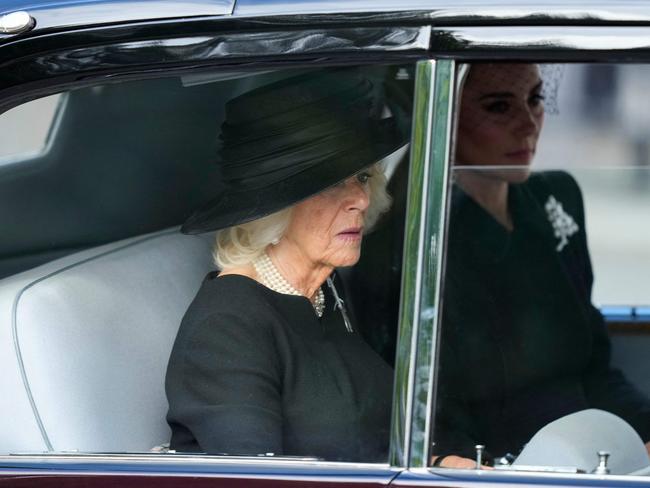

Following the conclusion of the procession from Buckingham Palace, the guards carefully removed her coffin from the carriage outside the Hall and carried it inside in unison.
Sitting atop the coffin, which is draped in the yellow and red Royal Standard flag, is the Imperial State Crown upon a purple velvet cushion.
The crown is made of gold and set with almost 3000 diamonds, 17 sapphires, 11 emeralds, 269 pearls and four rubies.
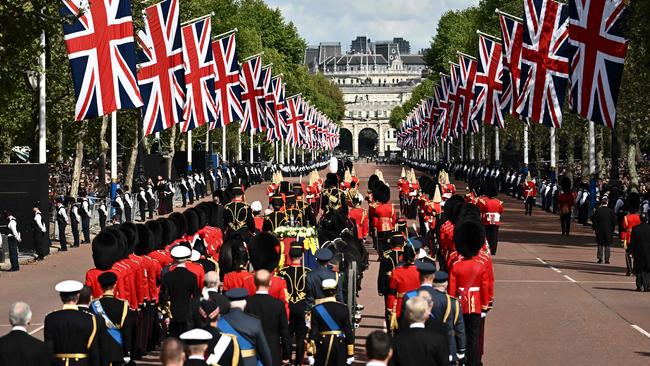

COFFIN LYING IN STATE AT WESTMINSTER
The Queen’s coffin has been placed on a raised platform – or catafalque – in the middle of Westminster Hall, to be guarded around the clock.
A service for the Queen was held shortly after her arrival at Westminster, led by the Archbishop of Canterbury, Justin Welby, and the Dean of Westminster, Dr David Hoyle.
It began with a reading from the Book of John, as well as the Lord’s Prayer.
During the service, the Cross of Westminster was ceremoniously placed at the head of the coffin.

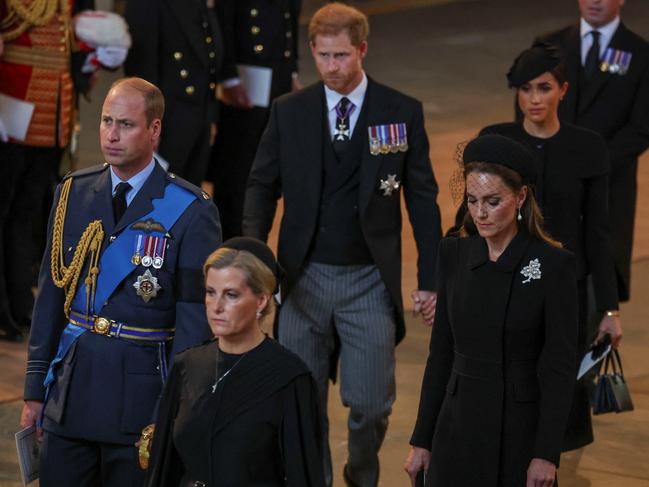
It features an inscription of the words by Isaiah 2:4: “Nation shall not lift up sword against nation. Neither shall they learn war anymore.”
Just before 3.30pm, the royal party exited the Hall as the service wrapped up.

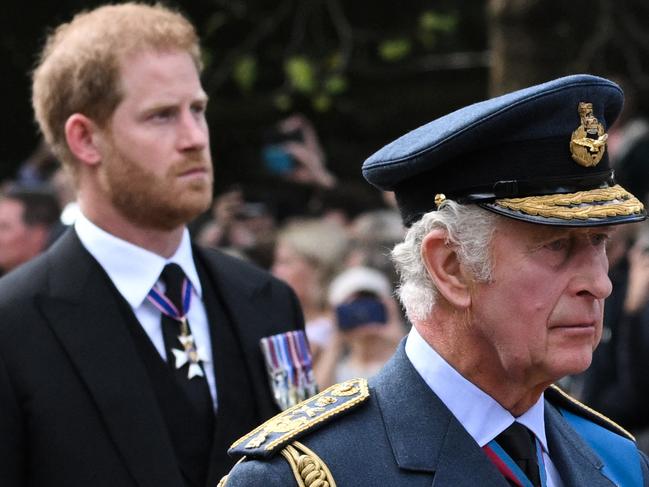
The new King, with Camilla by his side, paused at the door to share a private moment with the Archbishop of Canterbury, during which he appeared to offer gratitude for the ceremony.
The Archbishop responded with a bow of his head, saying “thank you” back to the monarch.
Once the family departed in a fleet of cars, Westminster Hall closed for one hour until doors reopened to allow the first members of the public inside to pay their respects to the Queen.
She will now lie in state for the next four days, following a vigil attended by members of the royal family this afternoon.
Earlier, King Charles drove from his home in Clarence House to Buckingham Palace.
The new King appeared visibly emotional as he waved to the crowds gathered around the royal London residence just before 11am, local time.
The Queen Consort, Camilla, later joined her husband at Buckingham Palace. She was dressed all in black and wearing a matching hat as she waved and smiled at the thousands of wellwishers lining The Mall.

Waking to rain, Londoners braced for moving scenes of a royal family farewelling the “ray of sunshine” who embodied a national identity as Britain’s treasured head of seven decades.
As they set down chairs early for prime positions, spectators confronted unprecedented security measures.
The queue to file past the Queen’s coffin is expected to extend attract more than 8km and attract more than 330,000 people.
Stephen Hallgate, 61, from London, arrived at 8am on Tuesday – 32 hours in advance – to be eighth in the line.
“Gradually, every hour there was a few (more) people coming and now there’s a lot lot more coming,” he said.
He described the experience of waiting more than 24 hours as “fabulous”.
“I didn’t get any sleep at all. I was running on the energy of the moment,” he said.
“It’s been a fabulous experience. We’ve had lots of fun and lots of laughs. No tears. The tears will come when we’re in front of the coffin I’m sure,” he said.
Her Majesty's’s 70 years of service will only really end on Monday with what will probably be the western world’s most watched funeral ever.
But don’t turn on the TV and watch the service for hints of Queen Elizabeth’s famed lighter side.
Instead, such stories will and ought to be told in private homes across Britain, probably over a champagne or two and a few tears.
The Queen once described a royal send-off as “a chance to show to the whole world the British nation united in grief and respect”.
“May we, each and every one of us, thank God for someone who made many, many people happy,” she said.
The Queen was talking about Princess Di’s send-off in 1997.
But she could have been talking about her own.
GOV-GEN SPEAKS TO KING CHARLES
The Governor-General David Hurley has spoken to the new king over the phone to express condolences of the people of Australia at the death of his beloved “mama”.
In a statement issued to the media, the Governor-General and his wife Linda spoke with King Charles over phone today to “convey the outpouring of emotion that has occurred across Australia” adding Australians felt his pain at the loss of the queen who died at her Balmoral residence on Thursday.
The Governor-General and his wife will travel to the UK tomorrow to meet the king in person.
Her Excellency the Honourable Linda Desseau AC, Governor of Victoria, will serve as administrator of the government of the Commonwealth of Australia during his absence over seas.
Originally published as Royal guard collapses; Harry and Meghan ‘break ranks’

